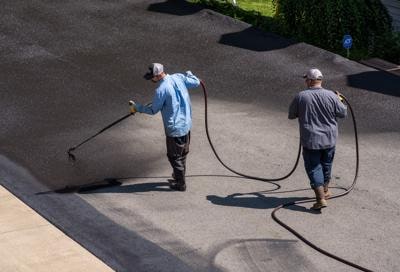Mastering Angled Parking: How Asphalt Sealing Improves Business Whole Lots
Mastering Angled Parking: How Asphalt Sealing Improves Business Whole Lots
Blog Article
Hot Mix Asphalt: A Sustainable Service for Pavement
Hot Mix Asphalt (HMA) has emerged as a leading lasting option for pavement remedies, supplying a myriad of cutting-edge technologies and environmental advantages. As the demand for environment-friendly building and construction methods grows, exploring the nuances of HMA's sustainability can give valuable understandings right into the future of sidewalk services.
Environmental Advantages of Warm Mix Asphalt

Furthermore, Warm Mix Asphalt helps to minimize urban heat island effects. Its dark shade absorbs sunlight, decreasing the quantity of warm reflected back into the atmosphere contrasted to lighter-colored sidewalks. This can lower ambient temperatures in metropolitan locations, reducing the demand for cooling and ultimately reducing energy usage.
Furthermore, Warm Mix Asphalt adds to enhanced stormwater monitoring. Its permeable nature allows water to charge and penetrate the sidewalk groundwater materials, reducing runoff and the risk of flooding. These ecological advantages make Warm Mix Asphalt a sustainable option for leading freeways and roads.
Energy Efficiency in HMA Manufacturing
Is power performance an important aspect in the production of Warm Mix Asphalt (HMA)? Energy plays a considerable function in the manufacturing of HMA, affecting both price and environmental sustainability. One essential aspect of power effectiveness in HMA production is the usage of cozy mix asphalt (WMA) innovations.
Additionally, developments in plant innovations have led to more energy-efficient HMA production procedures. By enhancing power usage in HMA manufacturing, the market can lower its carbon footprint while preserving top quality sidewalk products.
Recyclability of Warm Mix Asphalt
The recyclability of Hot Mix Asphalt (HMA) is an essential aspect of its sustainability and lasting environmental impact. HMA is one of one of the most recycled products in the United States, with over 100 million tons of redeemed asphalt pavement (RAP) being reused each year in new pavement building. Recycling HMA uses several ecological benefits, such as decreasing the demand for virgin products, decreasing power consumption during production, and decreasing the amount of waste sent to landfills.
The process of recycling HMA involves milling the existing pavement, crushing it into smaller pieces, and mixing it with new aggregate and asphalt binder to create a recycled mix. This content recycled mix can frequently execute along with or also better than traditional HMA, while calling for fewer raw products and generating lower greenhouse gas discharges. By incorporating RAP into new pavement jobs, roadway companies can preserve natural resources, minimize prices, and reduce the environmental impact of roadway building and upkeep tasks. Overall, the recyclability of HMA plays a substantial role in promoting sustainable techniques within the pavement market.

Long-Term Performance of HMA
Asphalt pavements show toughness and durability over an extensive duration, reflecting the lasting performance of Warm Mix Asphalt (HMA) Furthermore, innovations in HMA technology, such as the use of polymer-modified binders and warm mix asphalt, have additionally boosted the durability and durability of HMA sidewalks. By focusing on top quality construction and maintenance methods, HMA continues to confirm itself as a sustainable and cost-effective remedy for resilient sidewalk framework.

HMA: Sturdiness and Sustainability
Demonstrating both sturdiness and sustainability, Warm Mix Asphalt (HMA) has actually come to be a foundation in the building of durable pavement infrastructures - hot mix asphalt. HMA's resilience originates from its capability to endure hefty tons, extreme climate condition, and high website traffic quantities, making it a trustworthy option for highways, freeways, and airport terminal paths. The make-up of HMA, which usually consists of accumulations, binder, and filler, plays a critical role in boosting its durability and resistance to tear and use
Additionally, HMA's sustainability hinges on its recyclability and energy-efficient manufacturing procedure. The capacity to reuse recovered asphalt sidewalk (RAP) in new HMA mixes minimizes the need for virgin directory products and reduces the environmental effect of pavement building and construction and maintenance. Additionally, the power effectiveness of generating HMA exists in its reduced mixing temperature levels compared to other sidewalk products, causing decreased energy usage and greenhouse gas discharges.
Conclusion
In verdict, warm mix asphalt (HMA) uses a lasting solution for pavement with its eco-friendly qualities. HMA's recyclability, power effectiveness in production, and long-term durability make it an environment-friendly choice for road construction. By preserving natural deposits, decreasing waste, and lowering greenhouse gas exhausts, HMA plays an important role in promoting sustainability in framework development. Its capacity to mitigate metropolitan warm island effects better underscores its importance in producing resilient and eco conscious sidewalk systems.
HMA is one of the most recycled products in the United States, with over 100 million tons of redeemed asphalt sidewalk (RAP) being recycled every year in new pavement construction.The process of recycling HMA entails crushing the existing pavement, crushing it right into smaller pieces, and mixing it with new aggregate and asphalt binder to produce a recycled mix.Asphalt sidewalks show longevity and resilience over a prolonged period, showing the long-term efficiency of Warm Mix Asphalt (HMA) Additionally, improvements in HMA innovation, such as the use of polymer-modified binders and warm mix asphalt, have better improved the toughness and longevity of HMA sidewalks. The capability to reuse redeemed asphalt sidewalk (RAP) in new look these up HMA blends reduces the demand for virgin products and minimizes the ecological impact of pavement building and construction and maintenance.
Report this page